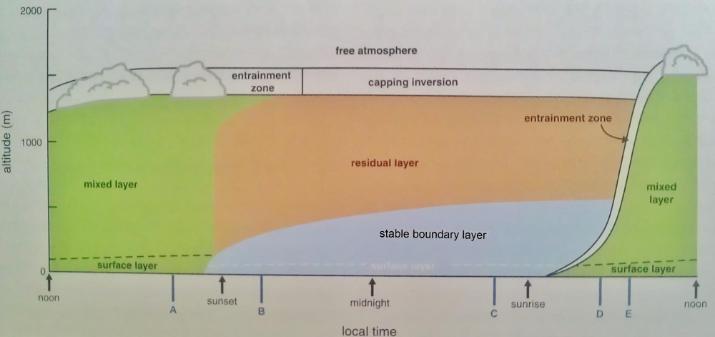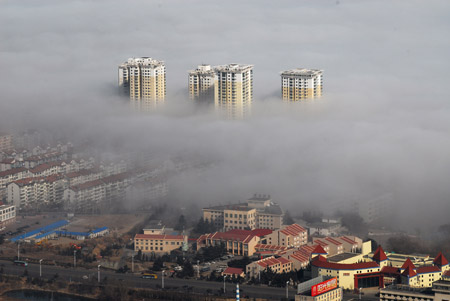"The thermal structure of the atmospheric BL and the height of the mixing layer are essential quantities when assessing the air quality and the vertical dispersion of air pollutants because they determine and limit the rate and the range of vertical dispersion of volatile substances that are formed or emitted near the ground” (Emeis et al. 2005). |
What is the Boundary Layer (BL)?
The boundary layer is the part of the troposphere that is directly influenced by the presence of the Earth’s surface, and responds to surface forcings, such as heating and evaporation, with a timescale of about an hour or less [16].
Stability in a Boundary Layer
The atmospheric conditions will determine the stability of the boundary layer. From basic chemistry, warm air is less dense than cold air, so if a colder chunk of air is placed in a warmer atmosphere, it will sink back to its original position.
What does stability in the atmospheric science terms mean? Look at the image below while you read the explanation.
Panel a. is showing unstable conditions. A ball is placed on top of a hill, and if it becomes displaced, it will keep moving away from its original position. Similarly, in the unstable atmosphere, a parcel of air displaced upwards (downwards) will continue moving upwards (downwards). This would be the case if the temperature decreases with height.
Panel b. is showing stable conditions. The ball is now placed in the valley. If we displace the ball upwards, it will roll back to its original position. In case of the atmosphere, a parcel of air will return to its original position as it will be cooler than the surrounding environment.
Panel c. is showing neutral conditions. If the ball, or a parcel of air is displaced, it will stay at its new position.


During the day, the ground heats up due to the energy from the sun. Surface is then much warmer than the atmosphere aloft, leading to an unstable profile. Convection can occur from thermals (blobs of warm air) rising from the surface. This process allows the atmosphere to mix, leading to constant moisture content and potential temperature throughout the layer with height [13].
After the sun sets, heating and turbulent processes are shut off. The ground cools by radiational cooling and forms a stable layer (SBL) above the ground. This profile consists of cold air near the surface with warmer air aloft. A stable layer is most likely to be present near a surface high pressure. Some of the key characteristics of a high pressure center are suppressed upward motion or prevalent downward motion and light, variable winds. Winds in a SBL are usually driven by local topographic flow, buoyancy, friction, or mixing processes [2],[13].
Weak winds generate weak turbulence and mixing, which allows for the buildup of cold air near the surface; thus increasing stability of that layer of the atmosphere [2],[3].
Stable Boundary Layer and Pollution
Models show that boundary layer stability and traffic activity are the two best determinants of urban aerosol concentrations [4].
The following three points are characteristics of the SBL that make air pollution a concern:
